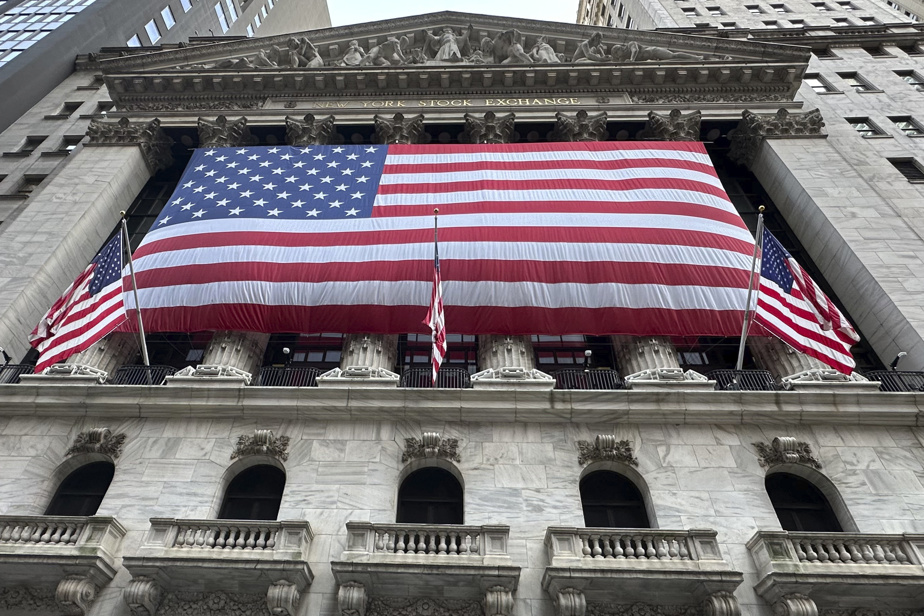(New York) After a rollercoaster session shaken by the announcement of strong job creation in the United States, the New York Stock Exchange ended slightly down on Friday, while remaining close to its records.
The Dow Jones index fell 0.22% to 38,798.99 points, the technology-dominated NASDAQ lost 0.23% to 17,133.13 points and the S&P 500 finally dropped 0.11% to 5346.99 points after breaking a new session record.
The main Canadian stock index fell 1%. The S&P/TSX Composite Index lost 222.10 points to close at 22,007.00.
The Canadian dollar traded at 72.78 US cents compared to 73.07 US cents on Thursday.
The American economy created many more jobs than expected in May with 272,000 hires, compared to 165,000 the month before and 190,000 expected.
These numbers are in themselves “good news for workers looking for jobs,” said Robert Frick of Navy Federal Credit Union.
But for the stock market, they mean that the labor market is still dynamic, also supported by an increase in wages, which a priori prevents a future reduction in rates from the Fed, the American central bank.
Bond rates jumped after the publication, rising to 4.42% instead of 4.28% for ten-year bonds, leading to a greater decline in stock indices at the start of the session.
This was followed by a surge in the dollar which gained 0.81% against the euro to 1.0802 dollars per euro, around 3:25 p.m. (Eastern time).
“These employment figures eliminate any chance that the Fed will cut interest rates in July,” said Ian Shepherdson of Pantheon Macroeconomics. He nevertheless continues to bet on a rate cut in September.
Investors were also cooled by the 0.4% increase in hourly wages in May, which rose over a year to 4.1% from 3.9%. Wage growth can fuel inflation.
The unemployment rate, measured by a separate survey, rose to 4% instead of 3.9%.
“This data does not leave much room for maneuver for the Fed. It’s the market that was initially sellers,” commented Adam Sarhan of 50 Park Investments.
He is already focusing on the CPI inflation index which must be published before the end of the Federal Reserve’s monetary meeting on Wednesday.
“If the CPI is lower than expected, that could open up the possibility for the Fed to cut rates this summer or perhaps in the fall,” he said.
On the market, seven sectors out of the eleven of the S&P 500 concluded in the red, notably real estate (-0.86%) which is very sensitive to the persistence of high interest rates which make real estate loans more expensive.
Within the Dow Jones, consumer-related stocks fell such as the hypermarket giant Walmart (-1.89%), the DIY chain Home Depot (-1.25%) and McDonald’s (-1.74%). ).
After a spectacular surge of 47% on Thursday, the viral and very speculative action GameStop collapsed by 39.36% to $28.23.
The event for the action of video game stores was the intervention in streaming on YouTube, for the first time in three years, of the stock marketer Keith Gill called “Roaring Kitty”, at the origin of the movement “meme stocks” – these titles carried by exchanges on social networks.
During a confused 50-minute intervention where in the background, the GameStop share curve was collapsing live, “Roaring Kitty” praised the brand’s restructuring efforts, renewing its confidence in the company. company in difficulty.
The stock fell after the company announced the sale of an additional 75 million shares and disappointing first quarter results.
Electronic signature company Docusign fell 4.67% after reporting weaker-than-expected guidance for the second quarter even though its first-quarter sales topped expectations at $709 million.
Several medium-sized banks and financial institutions, which have a high exposure to commercial real estate loans, took a nosedive, like First Financial Bancorp (-0.88%) or Old National Bancorp (-1.09%).
The ratings of these establishments could be lowered, warned the Moody’s rating agency which examines the risks linked to commercial real estate.
The S&P/TSX index is down more than 200 points
Canada’s main stock index fell 1% on Friday, led by the industrials, utilities and base metals sectors.
The S&P/TSX Composite Index lost 222.10 points to close at 22,007.00.
The Canadian dollar was trading at 72.78 US cents, compared to 73.07 US cents on Thursday.
